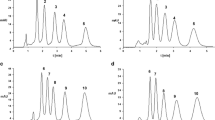Abstract
The reversed-phase ultra-high-performance liquid chromatography quadrupole time-of-flight mass spectrometry method was developed during the study and successfully applied to separation and analysis of unmodified and antisense oligonucleotides. It was shown that oligonucleotide separation strongly depends on the stationary phase type. The type, pH and salt content in the mobile phase influence also their chromatographic behavior and mass spectrometry sensitivity: increasing the apparent pH causes retention decrease and increase of sensitivity, while increasing the salt concentration produces greater oligonucleotide retention and lower sensitivity. Utilization of octadecyl stationary phase with aryl rings in reversed-phase mode allows successful separation of various modified and unmodified oligonucleotides, differing in length or sequence. The developed method has numerous advantages over current liquid chromatography methods: resolution is comparable to ion pair chromatography; oligonucleotides are analyzed with salts, which allow easy purification and separation without losing column performance, whereas columns run in the presence of ion pair reagents degrade more rapidly. Moreover, the differences in mass spectrometry sensitivity between reversed-phase liquid chromatography and ion pair chromatography were not significant for the studied compounds. The developed method is an effective analytical tool for the determination of oligonucleotide impurities.







Similar content being viewed by others
References
Gilar M (2001) Analysis and purification of synthetic oligonucleotides by reversed-phase high-performance liquid chromatography with photodiode array and mass spectrometry detection. Anal Biochem 298:196–206
Fountain KJ, Gilar M, Budman Y, Gebler JC (2003) Purification of dye-labeled oligonucleotides by ion-pair reversed-phase high-performance liquid chromatography. J Chromatogr B 783:61–72
Stein CA, Castanotto D (2017) FDA-approved oligonucleotide therapies in 2017. Mol Ther 25(5):1069–1075
Zhang Q, Lv H, Wang L, Chen M, Li F, Liang C, Yu Y, Jiang F, Lu A, Zhang G (2016) Recent methods for purification and structure determination of oligonucleotides. Int J Mol Sci 17(12):2134
McWhorter S, Soper SA (2000) Conductivity detection of polymerase chain reaction products separated by micro-reversed-phase liquid chromatography. J Chromatogr A 883:1–9
Kanavarioti A (2019) HPLC methods for purity evaluation of man-made single-stranded RNAs. Sci Rep 9:1019
Fitz HJ, Belagafe R, Brown GL, Fritz RH, Jones RA, Lees RG, Khorana HG (1978) Studies on polynucleotides. High-pressure liquid chromatography in polynucleotide synthesis. Biochemistry 17:1257–1267
McFarlan GD, Borer PN (1979) Separation of oligo-RNA by reverse-phase HPLC. Nucleic Acids Res 7:1067–1080
Ivleva VB, Yu YQ, Gilar M (2010) Ultra-performance liquid chromatography/tandem mass spectrometry (UPLC/MS/MS) and UPLC/MSE analysis of RNA oligonucleotides. Rapid Commun Mass Spectrom 24:2631–2640
Matos T, Silva G, Queiroz JA, Bülow L (2015) Preparative isolation of polymerase chain reaction products using mixed-mode chromatography. Anal Biochem 489:73–75
McGinnis AC, Chen B, Bartlett MG (2012) Chromatographic methods for the determination of therapeutic oligonucleotides. J Chromatogr B 883–884:76–94
Kaczmarkiewicz A, Nuckowski Ł, Studzińska S, Buszewski B (2019) Analysis of antisense oligonucleotides and their metabolites with the use of ion pair reversed-phase liquid chromatography coupled with mass spectrometry. Crit Rev Anal Chem 49:256–270
Franzoni S, Vezzelli V, Turtoro A, Solazzo L, Greco A, Tassone P, Di Martino T, Breda M (2018) Development and validation of a bioanalytical method for quantification of LNA-i-miR-221, a 13-mer oligonucleotide, in rat plasma using LC–MS/MS. J Pharm Biomed Anal 150:300–307
Smith M, Beck T (2016) Quantitation of a low level coeluting impurity present in a modified oligonucleotide by both LC–MS and NMR. J Pharm Biomed Anal 118:34–40
Studzińska S (2018) Review on investigations of antisense oligonucleotides with the use of mass spectrometry. Talanta 176:329–343
McCarthy SM, Gilar M, Gebler J (2009) Reversed-phase ion-pair liquid chromatography analysis and purification of small interfering RNA. Anal Biochem 390:181–188
Levin DS, Shepperd BT, Gruenloh CJ (2011) Combining ion pairing agents for enhanced analysis of oligonucleotide therapeutics by reversed phase-ion pairing ultra performance liquid chromatography (UPLC). J Chromatogr B 879:1587–1595
Studzińska S, Buszewski B (2014) Evaluation of ultra high performance liquid chromatography columns for the analysis of unmodified and antisense oligonucleotides. Anal Bioanal Chem 406:7127–7136
Studzińska S, Rola R, Buszewski B (2016) Development of a method based on ultra high performance liquid chromatography coupled with quadrupole time-of-flight mass spectrometry for studying the in vitro metabolism of phosphorothioate oligonucleotides. Anal Bioanal Chem 408:1585–1595
Kaczmarkiewicz A, Nuckowski Ł, Studzińska S (2019) Analysis of the first and second generation of antisense oligonucleotides in serum samples with the use of ultra high performance liquid chromatography coupled with tandem mass spectrometry. Talanta 196:54–63
Acknowledgements
The authors gratefully acknowledge professor Robert Zakrzewski for inspiring conversation.
Funding
This study was funded by the National Science Centre (Cracow, Poland) under Sonata Bis project (2016/22/E/ST4/00478).
Author information
Authors and Affiliations
Corresponding author
Ethics declarations
Conflict of interest
All authors declare that they have no conflict of interest.
Ethical approval
This article does not report any studies with human participants or animals conducted by any of the authors.
Additional information
Publisher's Note
Springer Nature remains neutral with regard to jurisdictional claims in published maps and institutional affiliations.
Electronic supplementary material
Below is the link to the electronic supplementary material.
Rights and permissions
About this article
Cite this article
Studzińska, S., Nuckowski, Ł. & Kilanowska, A. Ultra-High-Performance Reversed-Phase Liquid Chromatography Hyphenated with ESI-Q-TOF-MS for the Analysis of Unmodified and Antisense Oligonucleotides. Chromatographia 83, 349–360 (2020). https://doi.org/10.1007/s10337-019-03844-4
Received:
Revised:
Accepted:
Published:
Issue Date:
DOI: https://doi.org/10.1007/s10337-019-03844-4




